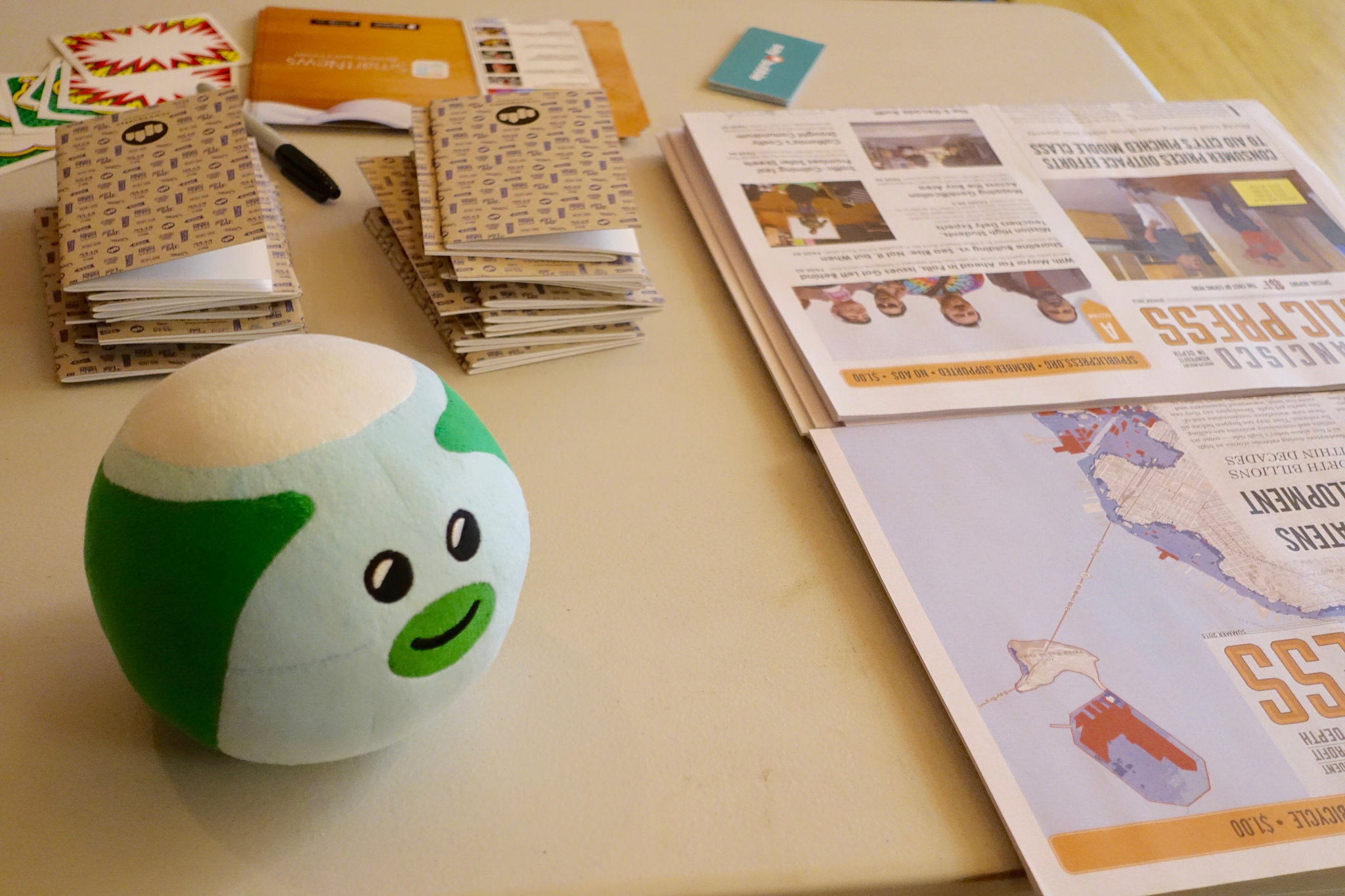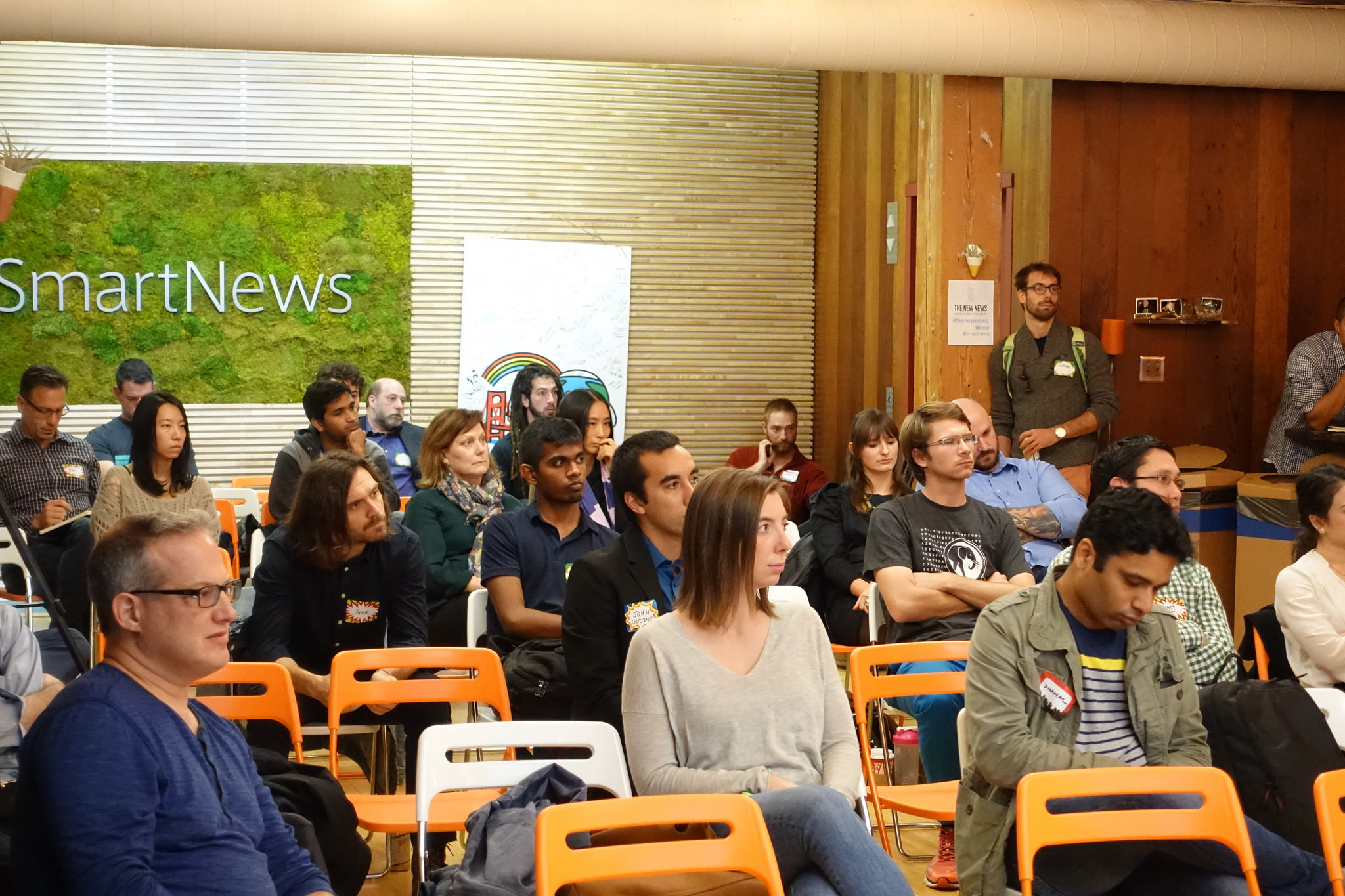Cracking the Code of Local News
In his opening remarks, Rich Jaroslovsky, VP for Content and Chief Journalist at SmartNews, said that Local News is something that everyone has tried but, “nobody has fully cracked the code.” Backfence, Topix, Patch, and countless other valiant efforts have taken a run at it but failed to sustain. “Local News is still a huge opportunity because of the intensity for what people want,” Rich continued. Sharing a datapoint from SmartNews, we see almost double the CTRs on our local channels (the SmartNews app has 23 existing with several more in development).
With this context, SmartNews and Pocket hosted the first New News meetup. The founding principal is to discuss the evolution or tell the story about a particular aspect of the News business. The inaugural meetup held last week was about Local News, its opportunities and challenges.

Sponsors from Say Bubble and Townsquared generously supplied the food and drinks.
The panel of guests included:
- Hoodline – Eric Eldon
- The Bold Italic – Sunil Rajamaran
- SF Chronicle – Jess McCuan
- SF Public Press – Lila LaHood

From left, Lila LaHood of SF Public Press, Jess McCuan of SF Chronicle, Sunil Rajamaran (speaking) of The Bold Italic, and Eric Eldon of Hoodline
Each panelist presented a distinct business model for local news.
After writing for the tech press (VentureBeat, TechCrunch) Eric joined Hoodline where he is the Editor-in-Chief. Hoodline has built their own CMS and is using this technology to differentiate themselves. They have soft-launched an events listing service and will be using hyper-focused local reporting (i.e. Change is afoot at Rising Star Laundromat) to draw attention to those listings.
Sunil found out from a Facebook comment thread that The Bold Italic was abruptly shutting down last April. Someone from TBL reached out to him and within 8 weeks he made an offer that was accepted by the previous owners, Gannett. Sunil, a co-founder of Scripted.com, a freelance writer marketplace, took on The Bold Italic as new project. The challenge is to maintain high quality content at “1/25th the budget” which he aims to do by focusing on “evergreen” pieces (i.e. An Open Letter to Anyone Moving to San Francisco for a Tech Job) and leaving the resource-heavy “news” stories to other sites. Sunil comes across as very business-savy and he has brought the site back up to a half-million pageviews/month with just 3 editors on staff. If he can source writers from his freelance community at a price that makes economic sense, he could come up with a model that can be replicated in other metro areas.
Jess stated clearly that the 150-year old SF Chronicle, “is not a start-up” but with it’s deep archive and extensive resources plays to its strengths. Jess’ team of 10 reporters, 2 editors and dedicated copy-editors & designers cover tech in the Bay Area and balance the spark and flash of the beat with the sober need to inform the public. Not many people know that SF Gate and SF Chronicle are not only two different sites but also two different organizations with different missions. “If you want to read about Justin Bieber’s butt, come to SF Gate, it’s the candy.” SF Chronicle is the premium content site, “the medicine” where they feature high-quality journalism about money, politics, tech, and other important forces changing the landscape of the Bay Area.
Lila describes the non-profit SF Public Press as an online & print version of NPR. They sell memberships to their quarterly newspaper but also raise funding from grants and donors. They are admittedly “slow news” and focus on big investigative reports which take many weeks to put together pulling data from FOIA document requests, interviews, and data analysis to create meaty articles featuring beautiful visualizations and maps (i.e. Building on the Bay, Sea Level Rise Threatens Waterfront Development). As a non-profit they need to work with like-minded organizations such as the local public radio stations, Mother Jones magazine, Bay Nature, Earth Island Institute, and the Center for Investigative Reporting to amplify their stories and get the word out about their stories.

Geography defining communities
A member of the audience wanted to know how each site covered issues which cut across geographic boundaries. Hoodline has a “density formula” to determine which neighborhoods to cover but Eric was quick to note that when it came to certain issues such as gentrification it was important to maintain objectivity to build trust.
Sunil noted the monetary challenge of local which limits The Bold Italic’s attractiveness to national advertisers. Jess touted the Chronicle’s deep archive of coverage of big national stories such as the LGBT community which helped them put together an impressive package of historical pieces for their Marriage Equality Act issue which went on to become one of their best-selling issues.
The focus on a pieces that resonate with a local audience but tell a good story about an important national trend is what makes Jess most proud. The Chronicle has ambitions to be a national paper and she is aware that, in many aspects, the world is paying disproportionate attention to the Bay Area as a leading indicator of national trends that are impacting the rest of the United States. Tech touches on important issues regarding privacy, security, First Amendment rights, and the sharing economy. Many of the global players are here.
When a new batch of census data came out showing the rise in median income from 2009 to 2014 there were numerous local angles to the story. The piece that struck home was a piece by local reporter Joaquin Palomino about a local bakery in the Mission that had been selling the local community empanadas but recently switched to vegan carrot cake and organic coffee in order to stay in business.
Events or No?
Because media companies are in the business of aggregating audiences and connecting them with their sponsors, events are a logical way to bring together their audience in real life. Events were an important part of The Bold Italic’s previous business model and were the #1 source of revenue. In reality, Sunil admitted, the margins were “razor thin” so, going forward, events will not be part of “the new iteration” of TBL.
Eric from Hoodline also has experience with events in his previous life at VentureBeat and TechCrunch where large events such as The Crunchies and Disrupt were important but ultimately a “distraction” from the reporting and building product.
Jess stated emphatically that the SF Chronicle, “is not in the events business” but did share a preview of an upcoming documentary film they are producing about men living with HIV that will have a opening night event at the Castro Theatre.
By contrast, the SF Public Press looks at events as an important fundraising activity and has the occasional open house and has hosted hackathons such as the recent Hack the Housing Crisis conference to engage with the local community to address a specific concern.
Is Local Profitable?
To everyone’s surprise the local papers are turning a profit. The Bay Area News Group, with 14 daily and 32 weekly newspapers, is an important targeting vehicle for local business.
Showing that he’s well aware of what he’s getting into with reviving The Bold Italic, Sunil said that you need to build a site that is profitable from the first pageview. “ADD is the challenge,” you cannot rely on your readers for that elusive second click and certainly should not predict revenues based on that. Social platforms such as Pinterest have added “buy” buttons in attempts to monetize the attention they are getting but with mixed results as their audiences have not yet migrated their intentions when they visit the site from browsing to buying. The big ticket acquisitions of Bleacher Report and HuffPo from the last up cycle show that there is an appetite for media acquisitions but he is patient to wait out this current downturn and is prepared to patiently build up a sustainable business for the long term.
The SF Public Press is having fun with experimentation. Because they have less to lose, they have a larger appetite for risk. “Constraints inspire creativity but more resources would be better!”
The SF Chronicle knows they will always be outgunned by the national tech press in sheer resources but celebrate their victories which effect real change. Jess shared the story of “soft-spoken Wendy Lee” who worked on a story about bus drivers for Apple, eBay, and Genetech who were forced to sleep in their minivans because they didn’t earn enough to live in the Bay Area. The front page story was a wake up call to the PR departments of the high tech giants “scared to death” of it becoming a national story and quickly turned things around and gave their drivers raises.
Strong local stories draw attention and the paper is cashing in on its readership. Poytner recently reported that the San Francisco Chronicle is profitable thanks to an in-house ad agency that provides, “Madison Avenue-type marketing consultancy and advertising agency services at a palatable price for a large regional brand.”

Who else is doing good work?
Each of the panelists shared other companies and organizations doing good work.
- DNA Info for New York and Chicago local news.
- Corner Media Group for their coverage of Brooklyn.
- Institute for Non-profit News for their support of investigative reporting.
- LION (Local Independent Online News publishers) is a great resource for local news providers to meet each other.
- ONA (Online News Association) is another organization with many local chapters.
- The Atlantic was highlighted for their top notch journalism and Quartz was mentioned as having mobile particularly well done.
- ProPublic is also doing great investigative journalism.
- Sunil pointed to Mic as brilliantly designed to draw you deeper into the site and view more pages. He went on to note that while Buzzfeed does great with its viral content, it’s news vertical is not getting traction.
Other Coverage:
- Meetup Page – Join the New News meetup group to learn about future events. The next meetup on (Jan. 21st, VR Storytelling) is already being planned
- The New News @tnnsf
- Flickr Photoset
by @iankennedy


